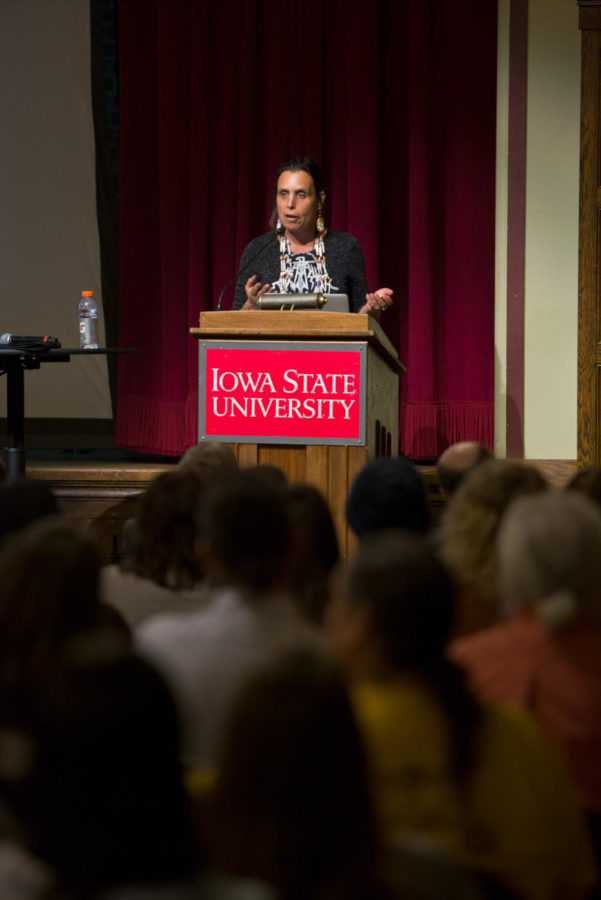Sustainable Agricultural Lecture from Economist, Activist and Farmer Winona Laduke
An environmental activist and advocate for Native environmental groups, Winona LaDuke spoke in the Great Hall of the Memorial Union on Wednesday, March 28. She began her talk by speaking about her people’s food supply, wild rice.
March 29, 2018
In the age of genetic engineering and agricultural monopolies, there are communities that farm 1,000 year crops without petroleum powered technologies. And they’re doing just fine.
They’d be doing better if they didn’t have to dedicate so many resources to protecting their croplands from agricultural monopolies and pipeline investors, so says indigenous activist and Harvard educated economist Winona Laduke.
“Food is more than just what you eat,” Laduke said. “It’s part of our culture, it’s part of our heritage.”
Laduke is a writer, economist and farmer. She spoke to more than 500 people at the Memorial Union on March 28.
She acknowledged the U.S. is seeing troubled times. People are divided politically, economically and ideologically, but many people share an interest in dramatic social change.
“America was great when we had over 8,000 varieties of natural and organic corn,” Laduke said. “Corn that was made by a lot of brown people and mostly brown women. That’s when America was great, when there was tremendous agrobiodiversity across the country, or when there were over 50 million buffalo in the U.S. that migrated across the continent, and were the furthest migrating land species that ever existed.
America was great when millions of passenger pigeons layered the sky. America was great when we could drink the water.”
Laduke grows a variety of crops, including traditional species of corn and rice in the Ojibwe lands of what is now Minnesota. She spoke about her experience in activism, specifically protests against Enbridge Energy pipelines over the last decade when pipelines threatened to cut through indigenous farmlands.
It was not hard to get the indigenous populations riled up about the pipeline, but they couldn’t mount the protest on their own. Laduke set out to form a multicultural community response to Enbridge Energy, which combined indigenous movements with the efforts of white Minnesotans of mostly German and Norwegian heritage.
“I had to go out and educate myself about pipelines, then I had to inform my community because I believe informed citizens are better in a democracy,” Laduke said. “My idea was to see if we could get the Norwegians mad and get something done. We developed a multicultural opposition against the sandpiper pipeline.”
Laduke’s opposition to energy industries wouldn’t end there. She and thousands of other activists traveled to Standing Rock to protest the Keystone Oil Pipeline in 2016, and she is preparing for a potential battle with Enbridge Energy this June.
“I’m not opposed to pipelines,” Laduke said. “I think water and sewers are great. It’s really about what’s in the pipes that concerns me, and you can’t have rice with oil in it.”
One of Laduke’s main focuses is food sovereignty, the practice which ensures people have the means to feed themselves.
“One day you might not be able to purchase your food at the store,” Laduke said. “The people of Puerto Rico are experiencing that right now.”
This points to the core of Laduke’s message, that we could all stand to reconsider how we think about our food.
“I really liked what she said about agricultural and cultural monocrops,” said Jackson Greenwaldt, junior in English. “She had a way of weaving in her experiences as a farmer with the political atmosphere, it was a fresh and realistic populist message.”
Laduke believes agriculture specialists should focus on genetic biodiversity instead of genetic modification, citing the Irish potato famine. The Irish people didn’t have enough biodiversity to sustain themselves after a disease began wiping out potato crops, and more than a million people died.
“Seventy percent of our food doesn’t come from Monsanto or Syngenta,” Laduke said. “It comes from peasant farmers around the world. Genetically modified food is not feeding the people of the world.”
It’s not just that genetic engineering isn’t necessary. Laduke also says it severely limits the potential for biodiversity, which exists naturally.
“There was a time when indigenous Americans had over 103,000 varieties of seeds,” Laduke said. “Now we are whittling that down to about one thousand.”
Laduke has also begun growing industrial hemp. Devoid of THC, this plant would offer a sustainable alternative to manufactured fabrics for clothes and other materials.
“It takes about 5,280 gallons of water to make a cotton shirt,” Laduke said.” It also consumes 24 percent of the world’s pesticide. What we’re wearing is toxic. We’re seeing a growing issue of microfibers in water.”
Laduke pointed to hemp as an alternative, which, in fact, was once quite popular.
“Until 1920, about 80 percent of our clothes were made from hemp,” Laduke said.
However, the U.S. doesn’t have any mills that could process the hemp. Those jobs were all exported overseas decades ago.
“We don’t have any mills here because we outsourced the mills to China,” Laduke said. “We have to re-industrialize this country. We don’t produce in this country, we shop.”
Laduke’s efforts illustrate a model for a new economy where the needs of the people have a direct relationship with the needs of the land.
“I wasn’t used to there being an alternative to the status quo of corporate agriculture,” said Alex Blonigen, senior mechanical engineering. “She spoke of all these different ways of doing business and growing food which I didn’t know were options. It was very powerful, especially in an environment that’s more divided than ever.”
Laduke pointed to agriculturalists like Will Allen, whose urban farming group “Growing Power” managed to produce a million pounds of food on just 3 acres of land.
“If he can do it, we all can do it,” Laduke said.
















